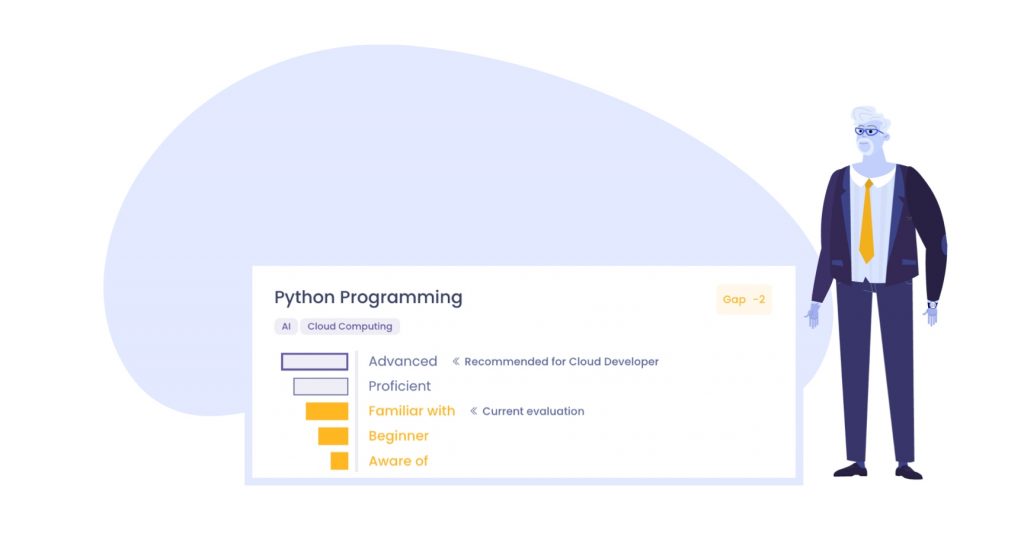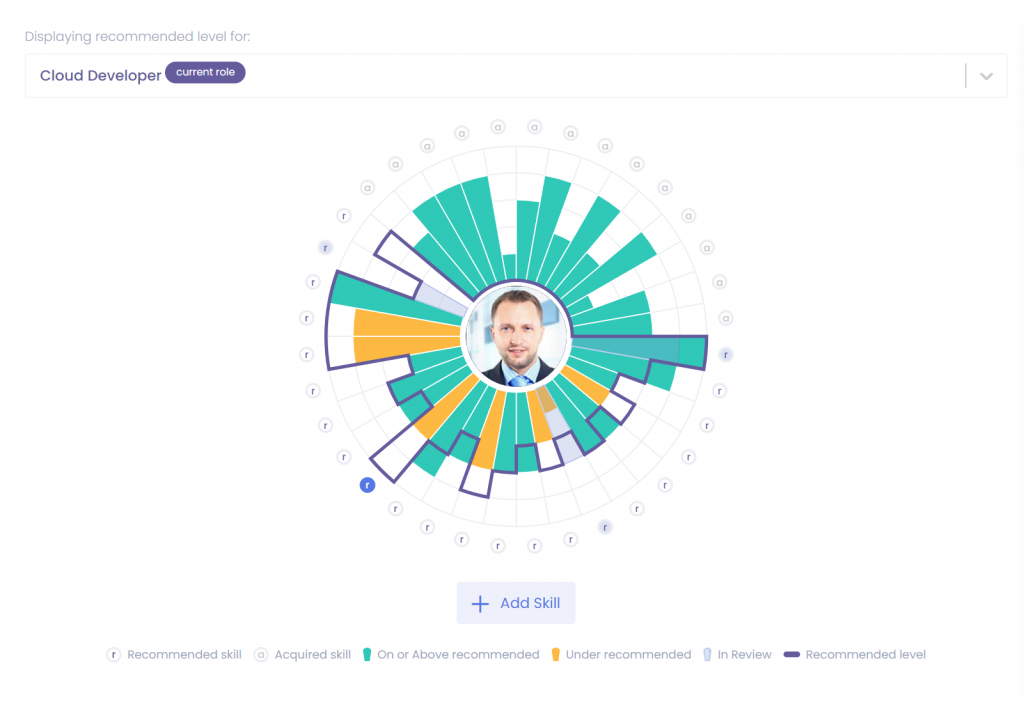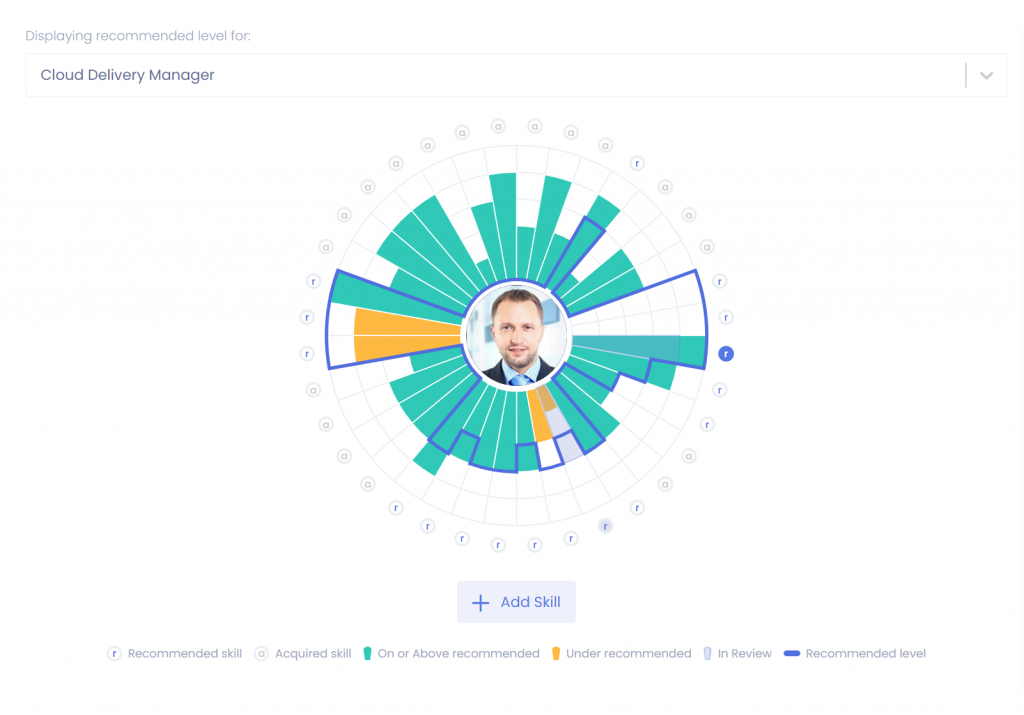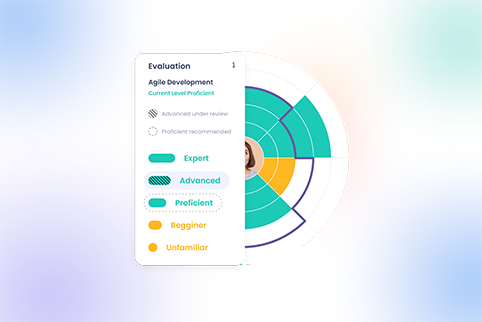Without skills visibility, it is impossible or at least extremely difficult to identify skill gaps, prioritize development opportunities, or take full advantage of internal mobility programs. And when it comes to visibility, a skills profile leveraged by skills management platforms provides clarity into workforce skills and capabilities, whether they match business requirements, and how to focus the efforts toward the most effective skill-building initiatives.
In this fast-paced business world of today, marked by changing needs and new technological capabilities, companies cannot afford employees with outdated skills. HR and business leaders alike must be fully aware of their workforce capabilities and help them evolve and adapt their skill sets to stay productive and impact business outcomes.
Especially since LinkedIn data shows that skill sets for jobs have changed by 25% since 2015 and are projected to shift by 65% by 2030 globally.
Combine this with the alarming insights from a 2023 report from McKinsey showing that only 50% of the respondents say their organizations already have the capabilities they need, and things are clear: organizations need to understand what skills they have and what skills they are missing to proactively prepare for the evolving future of work.
That’s where the employee skills profile comes in. And that’s what we’re focusing on in this article. So, let’s dive right in!

What is a skills profile?
An (employee) skills profile helps display all the skills and proficiency levels of a particular employee. On the Nestor platform, each profile also includes the most recent evaluation of that employee (for each skill).
One of the main goals of a skills profile is to provide skills visibility to managers and workers alike and offer access to a more holistic, visual, and easy-to-understand view of someone’s full skill set and competencies required for a particular job role.
As a direct result (of adopting it), organizations enjoy transparency over skill gaps and guide people to grow by either further developing their existing skills according to the recommended levels or by acquiring new skills and preparing for other roles within the organization.
Skills overview

Above, you can see the skills overview of a made-up employee, Antoine, who is a Cloud Developer. This overview is part of every skills profile on the Nestor platform and includes:
- Current job role/title
- Average (skill) proficiency level: 3.1 out of 5 in our example
- Number of skills that have been evaluated: 20 out of 22 above
- Number of job roles specific or recommended skills (both hard and soft). These skills are required for the current role, validated together with the manager, and cannot be changed (added, edited, or removed by the employee): 20 in our example
- The number of acquired skills. These skills come from other jobs or experiences and aren’t related to the current role. Each employee can add these skills and self-evaluations without the manager’s input. They can also choose to make them visible to everyone or only to them and their manager: 14 in our example above
- The number of desired skills. These are abilities that the employee wants to develop going forward. Each employee can add them to this list based on their interests and career aspirations: 4 in our example
Here, Teresa Rose, an award-winning learning and performance consultant interestingly highlights that:
You don’t want to really put anything more than like 15-20 skills on someone’s profile. They might be able to add more themselves. It’s really important that the employee has control over their profile and they can add more skills that might be, you know, from their history.
— Teresa Rose

Skills proficiency levels
Each skill is also accompanied by a recommended proficiency level (for that specific role) and the current or actual level (evaluation) of the employee for that particular skill. We use a 1-5 grading system:
- Aware of
- Beginner
- Familiar with
- Proficient
- Advanced
Here’s what it actually looks like for Antoine’s Python Programming skill:

This section (which is part of the skills dashboard) includes the name of the (selected) skill and the difference between the current evaluation and the recommended proficiency level.
In our example, Antoine is Familiar with (level 3/5) Python Programming but needs to reach the Advanced level (5/5), which is recommended for his Cloud Developer role. This is also highlighted by the ’Gap -2’ in the top right corner.
Skills dashboard
The skills dashboard includes many useful insights at a glance, including all the skills Antoine currently has, the current proficiency for each one, and any gaps related to his role requirements:

The dashboard is very dynamic and can also reveal the skills required for the next desired job:

If Antoine decides to pursue this new role (Cloud Delivery Manager), he can easily add the missing skills to his desired skills list. And then gradually work on acquiring and developing them over time so that he increases his chances of getting that role during a future internal recruitment process or as a promotion.
Why are employee skills profiles important?
Offer clarity and transparency over job requirements
A skills profile helps employees have a clear and real-time overview of their abilities and how they measure against the skills and proficiency requirements for their current (or future) role.
This transparency also enables people to identify areas for skill development and career advancement, which encourages growth within your organization and contributes to fostering and maintaining a culture of continuous learning.
Encourage employees to build and expand their skills
As presented earlier, the dynamic skills dashboard in the Nestor profile enables any worker to quickly see the skills and proficiency levels they are currently missing or falling short of — either for the current role or for the next one that they are targeting.
This removes the ambiguity that often comes with the process of making a vertical, lateral, or cross-departmental move. The employee is left with a simple and clear list of skills and competencies they need to improve to perform better or advance in their career. The next step is to simply add these skills in the desired skills section of their profile and gradually work toward developing them.
Skills profiles streamline career paths
The career moves section leverages the information from the skills profile to automatically display the current gaps in relation to potential career paths.
For example, in Antoine’s case, we know he needs to upskill in 4 areas and acquire 2 new skills to become a Cloud Delivery Manager. And here’s the visual representation of that in the career moves section:

Enable talent sharing and cross-departmental collaboration
Another advantage of using skills profiles across the entire organization is that it encourages people managers to share their top performers and allows other team leaders to ‘borrow’ them and their skill sets for temporary tasks and projects.
This can be beneficial to everyone, especially to organizations that have (already) adopted and nurtured flexible workforces with the goal of bringing together agile teams to quickly address specific tasks or emerging challenges.
This skills-based collaboration also serves in breaking down silos and creating a more synergistic work environment, which inevitably leads to a better understanding of what other teams or departments are doing and how it all contributes to the larger mission of the company.
But how does this work in practice? Our platform automatically uses the data from individual skills profiles to match or show the compatibility of candidates with the internal opportunities from the talent marketplace.
For example, Antoine has a 67% compatibility with this project posted by Anna, his (made-up) manager:

And this is only one of the numerous projects available, and for each opportunity, Nestor displays the employee’s (skills-based) compatibility and the objectives with which the project is linked.
Support internal recruiting
Networking and “knowing the right person” often lead to scenarios in which highly qualified and skilled people aren’t offered the promotion or development opportunities they deserve. This isn’t the case with skills profiles, whose transparency acts as the basis for equitable decisions.
Anyone within the company can view the skills profile of someone else and develop a good understanding of their strengths, weaknesses, and compatibility with current vacancies or potential openings. This is especially useful for HR departments, which can focus their initial hiring efforts on internal recruiting and ask questions like:
- Do we have internal candidates who are qualified for this role?
- How can we determine their compatibility?
- What further development would they need to qualify for this role?
Thanks to skills profiles and a skills-first platform like Nestor, you can quickly find out the answers to all these questions.
Benefits of using skills management software to create and update a skills profile
Centralizes the process of tracking, measuring, and visualizing employee skills
While you might already be sold on the critical importance and potential of skills profiles, the truth is most organizations struggle to identify, evaluate, and gather skills (data) efficiently. In fact, it’s hard to even decide where or how to start.
This is where skills management software can make a huge difference, as it brings together, in one easy-to-access and easy-to-use place, all the necessary tools to identify and evaluate skills — self-assessment, 360 feedback, performance reviews — and effective ways to visualize skills data and insights, such as a skills matrix.
Provides a transparent and accurate overview of anyone’s current skills profile
Skills and competencies represent a much more accurate and (easily) measurable source of truth. And by making them transparent across the entire organization, you will encourage people to gain insights from each other, see how they compare to other (desired) roles, and better understand their shortcomings.
This can be viewed, in essence, as a healthy internal ‘competition’ that promotes growth through collaboration and knowledge sharing. It also reveals the skills prioritized by each individual as well as the skill set that people in higher-lever positions have — acting as inspiration and motivation for your most ambitious workers.
Links skills profiles to other processes, like performance management and L&D
The potential of skills profiles is huge, and most organizations that are serious about making this transition should also realize that they can connect these profiles with many other talent management processes, including performance management L&D — helping to make smarter decisions about talent.
The truth is skills have the power to act as a framework, or a common language at work as we like to put it, ensuring that everybody uses the same definitions and proficiency levels and that skills are the basis for improving everything, from internal mobility to the effectiveness of training programs and the successful retention of top talent — eventually leading to a situation in which the right people with the right skills are in the right roles at the right time, which is a win-win for everyone.
Final thoughts
As you can see, the numerous applications and use cases — benefiting both employees and organizations — of the skills profile make it a compelling and necessary solution for HR departments operating in the modern work environment.
At Nestor, our entire platform is designed with a skills-first approach, and our skills profiles are the foundation for continuous skills building, improved performance, targeted learning and development, internal promotions, and talent sharing.
Schedule a free demo to learn more about how a skills management platform can help your organization achieve workforce agility, increased performance, and employee growth.








